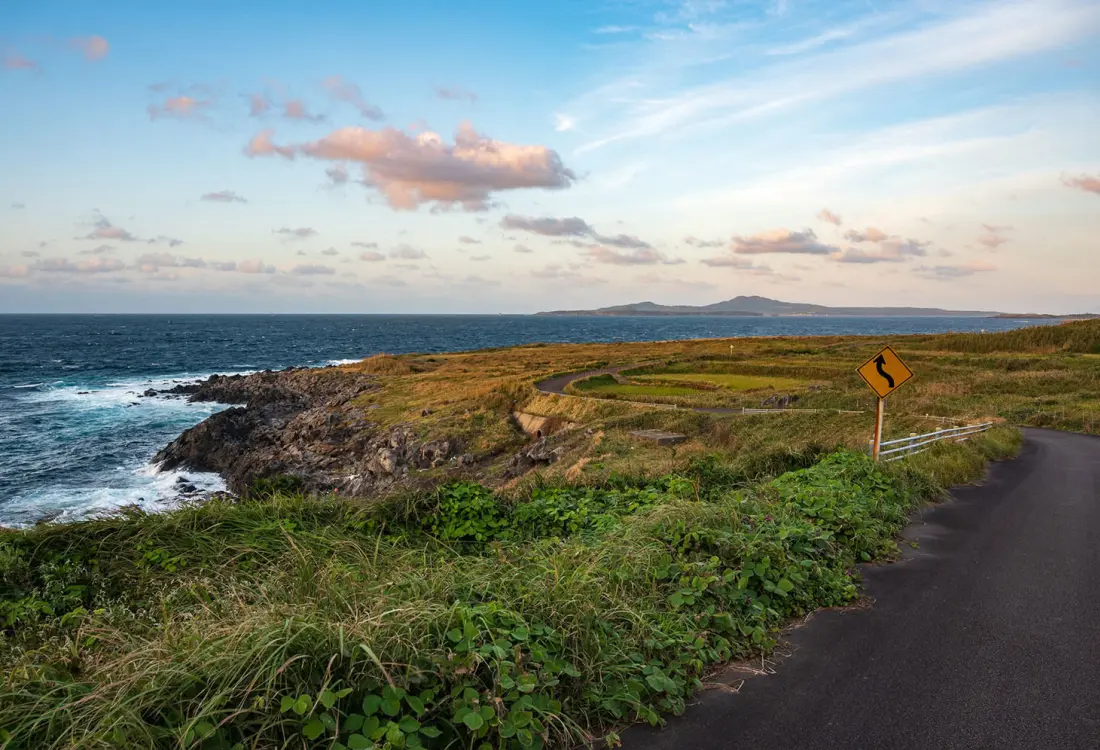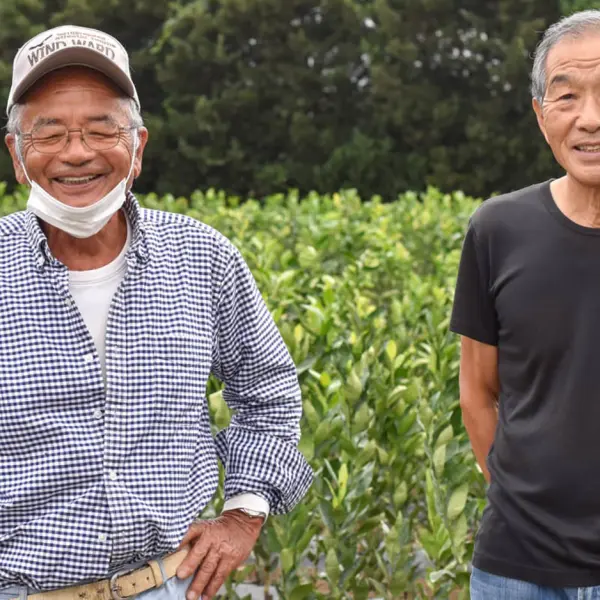
Ojika Island
Life In Japan’s Slow Lane
As a small island off the coast of Nagasaki, one does not come to Ojika Island by chance. You come to Ojika Island with intention, as I did, to find a sanctuary away from Japan’s crowds, with wide-open spaces and a cool sea breeze to fill my lungs.

Travelers arrive in Ojika Island by boat. The overnight ferry leaves Hakata Port in Fukuoka around midnight and delivers you bright and early in the morning, refreshed from a good night’s sleep. Or if you prefer to travel by day and at higher speeds, jetfoil boats bring visitors to the island from Sasebo in an hour and a half. Either way, you’ll arrive at the Ojika Island Ferry Terminal, where you can visit the tourism office inside. Like my guide Victoria, the friendly staff members are happy to advise you on things to do, help you arrange accommodations, or even book tours for you.
You’ll also be able to rent an electric bicycle here, on which you can zip around the island at your leisure. Head for Ojika Island’s most beautiful beach, Kakinohama, passing through the ancient Hime-no-Matsubara pine trees, which line the road on your way. The waters of Kakinohama are often calm and emerald blue-green, a perfect place to explore the coral reefs at the edge of the beach while snorkeling. Kakinohama Beach has full shower and restroom facilities, as well as platforms on which you can lie out and relax or even hang a hammock (rented from the tourism office).

I booked a sunset tour at the tourism office, and Victoria picked me up from my accommodations with plenty of time to spare before the sunset. She drove us to another famous Ojika Island landmark, the “Pothole,” a natural hole formed in the rock by water and pebbles swirling around inside for centuries. Near the pothole, an ancient white wooden torii gate stands alone in a green pasture. The torii’s shadow grew longer, and the sunlight warmer as the sunset hour drew near. Victoria drove me to some scenic places to take photos of Ojika Island’s incredible scenery of lush open spaces before we reached our destination. A large cow pasture made the perfect foreground for the setting sun streaming through brilliant clouds on the horizon. As we watched the sunset in silence and awe, I realized there was no one else in sight.

Solitude is easy to find in Ojika, where the local population numbers only a few thousand. Although there have been no cases of COVID on Ojika Island to date, they take precautions anyway, closing public facilities that are at risk of becoming too crowded and carefully controlling the capacity of restaurants, shops, and other public places that remain open. But most of the time, precautions aren’t necessary as you can easily choose to be completely alone. One of the easiest places to be alone is on nearby Nozaki Island. This island, which is now part of Ojika town, has been abandoned since 1971 when the last few families who lived on the island made the difficult decision to leave their homes behind. Today, the village’s ruins have new residents; wild deer roam through the remains, curiously eyeing visitors before bolting off into the shadows. Ojika Island runs a boat from near the ferry port, leaving in the morning and returning in the afternoon. I took the 30-minute trip with a group of excited schoolchildren, visiting the island to fish and kayak around the Nozaki Island port.

After exploring the village’s ruins, I made the leisurely hike over the hill to the Former Nobuki Church. This church was financed and built by the local Christian villagers after the ban on Christianity in Japan was lifted in the late nineteenth century. Though no longer used as a place of worship, it is maintained as a UNESCO World Heritage site commemorating Japan’s “Hidden Christian” heritage.

The adventurous can spend the night on Nozaki Island in a camping facility housed in a renovated schoolhouse. Perhaps there is no better definition of solitude than being virtually alone on an abandoned island for a night. Bring your own food to prepare and water to drink because you won’t find as much as a vending machine on the island. Stay up late, counting the infinite number of stars visible in the night sky, and fall asleep to the sound of chirping insects and the rustle of the breeze through the tall grass.
Ojika is a fertile island, and unlike the many nearby islands, was formed by a volcanic eruption, not seismic activity. Because of its geological origins, it is relatively flat and has plenty of land suitable for agriculture. Although Ojika is known for its seafood — rare and delicious abalone, chewy turban shell, and hirasu (the local amberjack fish) — they also produce local vegetables and rice. Fujimatsu, a restaurant in a renovated kominka (traditional house), serves innovative dishes based on the island’s local products; the chef himself selects the local ingredients he will use for the meals on any particular day. I arrived for dinner, and the attentive staff seated me in a private room overlooking a Japanese garden. However, my attention was held by the parade of gorgeous, delicious dishes that kept arriving in front of me.

After that incredible meal, I returned to my accommodations at Ichie-an, another kominka, which like Fujimatsu, was lovingly restored by American author and Japanophile Alex Kerr. Kerr was responsible for renovating half a dozen kominka on the island, making him a key figure in developing tourism on Ojika. Like his other work, Ichie-an was chosen as a renovation candidate for its “good bones,” a solid structure, great location, and interior details worth restoring. There was a comfortable futon laid out in the tatami floor sleeping area. The room included details like Japanese antiques and a piece of calligraphy created by Kerr himself, hanging in the tokonoma, a recessed area used during a Japanese tea ceremony. Two of the room walls are shoji screens of translucent rice paper, through which soft light filtered in from the surrounding engawa (outer hallway) during the day. A living space with a compact kitchen unit, dining table, and television is a place to relax, and the bath area is fully modernized for comfort. One could imagine spending the whole day relaxing in this peaceful space if it weren’t for the island’s natural beauty beckoning you to explore outside.

The next morning, I rose before dawn, and on my convenient electric bicycle, I rode to nearby Kakinohama Beach to witness the sunrise over Nozaki Island. As I rode leisurely around the island, residents greeted me with smiles and a hearty, “Ohayo gozaimasu!” (Good morning!) as they worked in their fields in the warm glow of the morning sun. I stopped by the local bakery Kojikoji Pan, which makes bread without milk, butter, or sugar, and instead uses the sweet flesh of local sweet potatoes. It was easy to find food you could take with you, carry in the basket on the bicycle, and eat alone while enjoying one of Ojika’s amazing views.

Later in the day, I met Hashi, a resident who runs a guesthouse on Ojika, who took me fishing for horse mackerel in the calm waters of a small port. Although we seemed to catch every sort of inedible fish under the sun, the mackerel, which was supposed to become part of our dinner that evening, eluded us. For over an hour, I baited and re-baited my fishing pole, caught and released dozens of tiny fish. Regardless, I had a wonderful time and a few good laughs with Hashi. As we prepared to leave empty-handed, two local fishermen who had witnessed our plight dropped their afternoon’s catch into our bucket so we wouldn’t go hungry that evening. Such is the kindness and generosity of the people of Ojika.

I could honestly say that I did nothing on Ojika Island, yet was completely satisfied with that nothing. For me, it meant there were no tasks to be done, no deadlines to be met, no place I needed to be. It was just me and this fertile little island off the coast of Nagasaki where one comes deliberately to escape from the pressures of life, if only briefly.
Stay in a Restored Kominka

Former Priest’s Home at Okinokojima Shrine

Ancient Pine Tree Grove at Hime-no-matsubara

Dine on Heiroku Sushi

Nozaki Island “Savanna”


Todd Fong
Photographer, mentor, story teller. Tokyo-based, Oaktown (Oakland, California) born. My writing and photography work includes Voyapon.com, "Sheila Kimono Style" (photo book), 365 Japan, and Metropolis. My curiosity about Japan, its culture and its history is matched only by the number of places in Japan I have yet to explore.
 Traditional Life in Shiiba Village, Kyushu’s Secret Hideaway
Traditional Life in Shiiba Village, Kyushu’s Secret Hideaway Follow the Canals: The Humble Beauty of Yanagawa
Follow the Canals: The Humble Beauty of Yanagawa Visit one of Japan's largest samurai residences in Izumi
Visit one of Japan's largest samurai residences in Izumi Katana Training & Omuta Exploration
Katana Training & Omuta Exploration 99 Islands and a Mouthful of History in Sasebo
99 Islands and a Mouthful of History in Sasebo Takachiho: Explorations of a mystical land
Takachiho: Explorations of a mystical land Meet the Locals at a Japan Farm Stay at Kagoshima
Meet the Locals at a Japan Farm Stay at Kagoshima Amami Oshima: Gorgeous island steeped in history
Amami Oshima: Gorgeous island steeped in history Yatai in Fukuoka: Sitting at the Counter with History
Yatai in Fukuoka: Sitting at the Counter with History Yakushima: Feeling the Island
Yakushima: Feeling the Island




